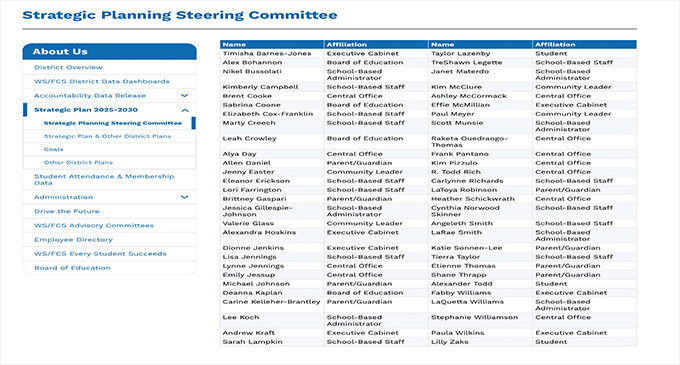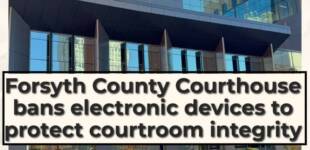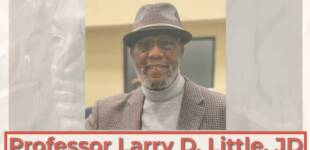Questions raised about WS/FCS Strategic Planning Steering Committee
Concerns have been raised about the process used to select members for the local school district’s Strategic Planning Steering Committee.

Concerns have been raised about the process used to select members for the local school district’s Strategic Planning Steering Committee. During the school board meeting on Tuesday, Feb. 25, several speakers let their frustrations be known about the makeup of the committee and the lack of diversity.
In January Winston-Salem/Forsyth County Schools (WS/FCS) announced that they started developing its 2025-2030 Strategic Plan and were seeking input from community stakeholders. Traditionally, the strategic plan is used to determine goals for the district related to student achievement, equity and access, community engagement, human resource development, and climate and safety.
The current strategic plan was developed in 2019 before the pandemic.
The new strategic plan is being led by Alex Bohannon, vice chair of the board of education, and Alexandra Hoskins, WS/FCS executive director of systems of coherence. When discussing the need to make changes to the strategic plan and request public input, Bohannon said it’s important that the district adjusts its educational strategies to reflect new circumstances that affect schools.
“Your strategic plan is supposed to be your north star that guides your organization in what its goals are and how you’re going to achieve them,” said Bohannon in a press release. “No matter what kind of organization you’re a part of, if you don’t have a strategic plan, you’re going to be operating very loosely.”
Hoskins said the goals identified in the current plan are still relevant, but the new plan is a chance to identify new priorities. She mentioned that the new priorities would be determined by the feedback they received from stakeholders.
Throughout January the district was in the “collection phase,” where they met with parents, students, staff and others in the community to discuss the next strategic plan. In February, the Strategic Planning Steering Committee was tasked with drafting a plan that will be available for public review in March. After revisions, the plan will go to the board of education for approval in May.
While attending a panel discussion on the strategic plan hosted by Forsyth Family Power, a local think tank driven toward ensuring equity, Karen Cuthrell started asking questions about who was on the committee that was deciding the future of our local schools. “On that day, I asked somebody on the panel ‘who comprises this committee? Where can I see the names?’ And they couldn’t tell me and that’s what inspired me to send the email,” Cuthrell said.
Cuthrell, who is the founder of The Feelings Company, which specializes in social and emotional products and programing, said she waited a week before sending an email to Hoskins requesting the names of those on the committee. In the email, Cuthrell also asked about the application process. After receiving the list of names, she was outraged to see the makeup of the board did not represent the demographics of the district.
In WS/FCS, 31.7% of the students are white, 30.7% are Hispanic, 29.1% are Black, 5.6% multiracial, 2.6% are Asian and less than 1% are American Indian/Alaskan Native or Native Hawaiian/Pacific Islander. The planning committee is 60% white, 35% Black, 4% Hispanic and 2% other.
“Black and Hispanic students make up 60% of this district’s population, yet their perspectives are absent from community leaders, parent representation and student participation in the Strategic Planning Steering Committee. This is unacceptable,” Cuthrell said.
Cuthrell also raised concerns about the lack of outside voices on the committee. She said that 65% of the committee are district employees. “There were four community leaders and all of them are white, and one has a contract with the district. That doesn’t represent us,” said Cuthrell while discussing her frustrations about the lack of community participation.
“By assembling a non-equitable, potentially biased, and district-employee-heavy committee, WS/FCS has effectively cast a vote of confidence in a governance structure that does not represent the district’s student body. Those responsible for forming this committee have, whether intentionally or not, prioritized district employees over independent community input and white voices over Black and Hispanic voices. This does not align with WS/FCS’s commitment to diversity, equity and inclusion, which still matters and is part of the current WSFCS Strategic Plan.”
To ensure transparency and accountability, Cuthrell has made several requests including a meeting with district leadership to discuss actionable steps toward a more equitable committee structure, a reduction in the number of district employees on the Strategic Planning Steering Committee to ensure that community leaders, parents and students have a greater role in shaping decisions, a written action plan detailing how WS/FCS will recruit and integrate Black and Hispanic representatives into the planning committee, and a commitment to disbanding and restructuring the current committee.
If changes aren’t made, Cuthrell said she will escalate the matter to the Office for Civil Rights.
Cuthrell isn’t alone with her complaints about the committee. Sumiya Carter, a senior at Parkland High School, said she doesn’t feel represented. Carter, who is Black, said, “I feel like it’s the opposite of what the district has been pushing for.”
Hate Out of Winston, a local organization geared toward fighting injustice, has also raised concerns. In a press release issued earlier this week, the organization called for the community to email the board of education and the superintendent demanding immediate action be taken.
The press release sent Wednesday, Feb. 26, reads, “This imbalance raises serious questions about whether the plan will truly reflect the needs and aspirations of our diverse student body. We cannot allow this critical document to be created without our community’s full and equitable participation.”
According to an email from Hoskins, they received 267 applications prior to the deadline. Hoskins and Bohannon met to determine the members of the committee based on the quality of the application and the affiliation of the candidates.
This is a developing story; updates will be made when new information is available.








